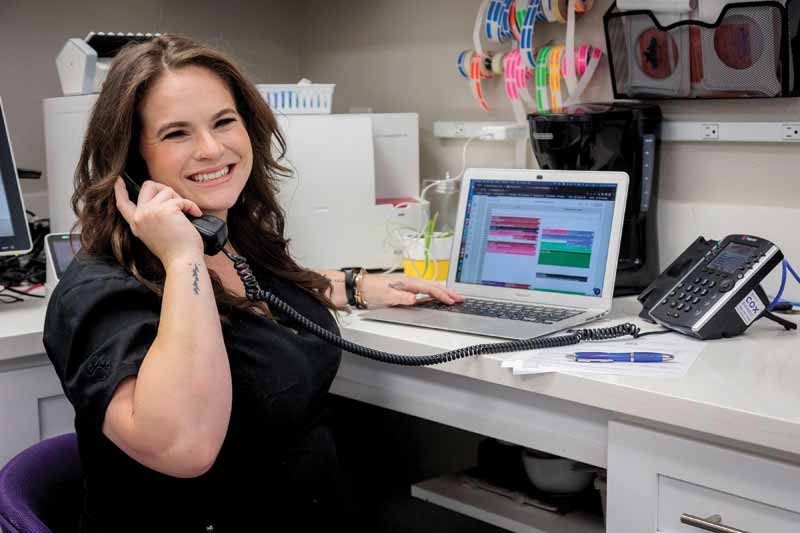
Photo courtesy Kaitlyn McMorran
When a rockstar client service representative (CSR) moved out of state, a Montana practice had the employee work remotely to answer phones, enter inventory, and manage equine travel health certificates. A New York hospital manager works from home one day a week to review financials, set doctor and staff schedules, and prepare performance reviews.
Remote work is a dominant trend in 2023, with 13 percent of full-time employees working from home and 28 percent blending a hybrid model of home and in-office work.1
While veterinarians, technicians, and assistants need to deliver onsite patient care, hospital managers and CSRs can do all or part of their work remotely. CSRs can answer phones, manage clinic emails and texts, schedule appointments, and call clients about overdue services and prescriptions. Managers can plan budgets, order inventory, create marketing initiatives, conduct virtual hiring interviews, write performance reviews, and complete tasks that benefit from focused, uninterrupted work. Remote workers can give your practice multiple advantages.
Attraction and retention
Millennials are the largest generation of the veterinary workforce, with women accounting for 78 percent.2 Remote work aligns with millennials’ affinity for flexibility, autonomy, and work-life balance.
“Everyone has wants, needs, and reasons to work from home. For me, it was the ability to stay home with my young children when the uncertainty of the pandemic was still lingering, and I could remain in my career field. The stars truly aligned,” explains Aimee Brulatour, who works from home in Port Saint Lucie, Fla., as practice manager of HomeVets, a mobile, in-home veterinary service in Baltimore, Md.
Brulatour values the flexibility, level of privacy you do not get in a clinic setting, as well as the savings on gas and commute time.
A recent study found 82 percent of respondents are trying to hire at least one employee and are experiencing difficulties filling jobs at their practices.3 Candidates now consider work-life balance and flexibility as the most important factors when evaluating job offers, with 81 percent saying they would be more loyal if they had flexible work options.4 Hybrid and fully remote jobs may help hospitals recruit and retain employees in competitive job markets.
When hiring a remote CSR, Brulatour sought candidates who are well-spoken because their voices are the face of the practice. “Veterinary experience is a must for us since training can have its challenges,” she says. “We use Google Meets for practice information management software training.”
HomeVets started completely decentralized and mobile in 2020 but recently bought a brick-and-mortar practice from two retiring doctors. Rebranded as HomeVets at Patapsco Valley in Ellicott City, Md., the practice is being remodeled and will reopen in October. The practice has four veterinarians and will give mobile HomeVets a facility to perform surgeries. Jordan Klaff, RVT, works as a mobile technician and remote CSR for HomeVets. Klaff manages calls for the mobile and brick-and-mortar practices, where an auto attendant menu routes calls to the remote CSR for scheduling and other inquires or to onsite staff if checking on hospitalized patients.
Increasing productivity
When working fully remote, 35 percent of employees feel more productive.1 They have fewer in-person distractions, the ability to design their own work environments, and reduced commute time.
“An employee who isn’t client-facing can be far more productive, have a better sense of well-being both personally and professionally, and have increased morale and retention when they are able to work outside of the clinic,” says Brulatour. “Although you are not onsite, you are more available to your team. Technology allows for document sharing and group edits, app communication, and virtual meetings. I can work late and still get dinner ready for my family or take an hour lunch and play outside.”
Working 100 percent remote, Brulatour’s hospital manager duties include staff schedules, payroll, benefits, budget and expenditure planning, social media and marketing, recruiting, staff training and meetings, performance reviews, biannual price audits, employee handbook, standard operating procedures, and employee events.
“If I have my laptop and phone, I can work from anywhere,” says Brulatour. “I don’t even need a printer! I use Google apps such as Sheets, Docs, Forms, and Calendar.”

Photos courtesy Aimee Brulatour
Reducing costs, reallocating space
The average real estate savings with full-time teleworkers is $10,000 per employee per year.5 With a hybrid model, a practice that has four CSRs could have two work onsite and two offsite. Remodel your lobby, converting a large front desk into a smaller workstation and repurposing the space for one or more exam rooms. The annual average revenue per exam room is $342,312 or $361 per square foot, according to AAHA’s Financial Productivity Pulsepoints.6 In larger practices with three or more full-time veterinarians, the average revenue per square foot for exam rooms increases to $514.
A manager with a hybrid work schedule could work from home four days a week and one day onsite, sharing workspace in doctors’ offices when it is an associate veterinarian’s day off. The manager’s office could be repurposed as a revenue-generating exam room. A shared workspace also reduces computer and phone expenses.
Embracing technology
When Kaitlyn McMorran moved from California to Arkansas, she wanted to continue her job as hospital manager of Jeronimo Pet Clinic in Mission Viejo, Calif. She worked remotely for more than a year. McMorran used Splashtop for remote access to the practice-management software and RingCentral, a cloud-based phone and fax app that works on a desktop computer and mobile phone. Remote work let McMorran focus on computerizing the practice after Dr. Barbara Weintraub bought it from a retiring doctor. McMorran helped convert paper charts into electronic medical records, create a website and social media presence, enter financial records in accounting software, set up a client communication app, and add an online pharmacy.
“I wrote a job description for the remote practice manager position and talked with Dr. Weintraub about it,” she says. McMorran traveled to the practice several times during the year for onsite meetings.
Now McMorran has moved backed to California and has a hybrid schedule, mostly working onsite but does a workday from home as needed. While working onsite at Jeronimo Pet Clinic, she serves as a veterinary assistant and hospital manager. McMorran also is attending school to become a registered technician. She values the job flexibility and plans to do more remote work during her maternity leave in December.
Weekly virtual meetings help Brulatour collaborate with HomeVet owners Drs. Shawn Budge and Brittany Wolfe. Each year, she travels to Maryland to spend a week working with the HomeVets team and recently attended the VMX conference with its doctors. Brulatour also created a private Facebook group called Mobile In-Home Veterinary Network where more than 200 remote veterinary staff exchange resources.
“Embrace the future and all that technology has to offer,” Brulatour advises. “Start slow. Work on a hybrid model first and figure it out one step at a time. Never stop growing.”
Wendy S. Myers, CVJ, has taught communication and client service skills for more than two decades. As founder of Communication Solutions for Veterinarians, she teaches practical skills through online courses, onsite coaching, and conferences. Myers was a partner in a specialty and emergency practice. Visit YouTube.com/csvets and Csvets.com for more.
References
- Haan K. Remote Work Statistics and Trends in 2023. Forbes Advisor. Available at: https://www.forbes.com/advisor/business/remote-work-statistics/#:~:text=As%20of%202023%2C%2012.7%25%20of,to%20a%20hybrid%20work%20model. Accessed July 24, 2023.
- Practice Inefficiencies Compound Veterinary Stress. JAVMA News. Available at: https://www.avma.org/javma-news/2021-12-01/practice-inefficiencies-compound-veterinary-stress. Accessed July 24, 2023.
- Groundbreaking IDEXX Study Reveals Opportunities to Increase Veterinary Practice Productivity. PR Newswire. Available at: https://www.prnewswire.com/news-releases/groundbreaking-idexx-study-reveals-opportunities-to-increase-veterinary-practice-productivity-301750165.html. Accessed July 24, 2023.
- Managing Flexible Work Arrangements. Available at: https://www.shrm.org/resourcesandtools/tools-and-samples/toolkits/pages/managingflexibleworkarrangements.aspx#:~:text=Many%20U.S.%20workers%20now%20consider,a%202020%20survey%20by%20FlexJobs. Accessed July 24, 2023.
- Hussain A. 4 Reasons Why a Remote Workforce Is Better for Business. Forbes. Available at: https://www.forbes.com/sites/amarhussaineurope/2019/03/29/4-reasons-why-a-remote-workforce-is-better-for-business/?sh=48a8fbe41a64. Accessed July 24, 2023.
- Hawn R. Hospital Considerations: Expand or Build New? Available at: https://www.mwiah.com/our-insights/hospital-considerations. Accessed July 24, 2023.
